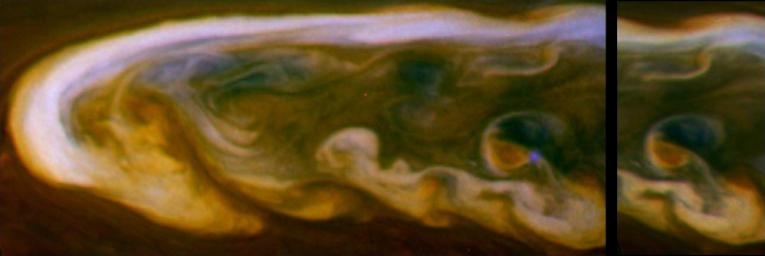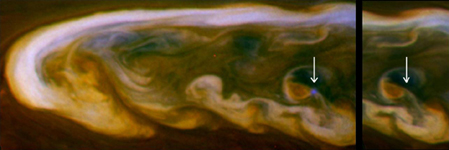
|
Lightning in Blue
- Click the image above for a larger view
- Full-Res JPEG (1283 x 429) (43.9 kB)
- Full-Res TIFF (1283 x 429) (1.7 MB)
Caption:

Annotated Version
Click on the image for larger view
These false-color mosaics from NASA's Cassini spacecraft capture lightning striking within the huge storm that encircled Saturn's northern hemisphere for much of 2011.
The larger mosaic on the left of the panel shows the lightning flash, which appears as a blue dot. The smaller mosaic on the right is composed of images taken 30 minutes later, and the lightning is not flashing at that time.
See PIA14904 for a mosaic showing a wider view wrapping around the planet also in which some blue lightning is visible in the clouds.
The white arrow in the annotated version of this panel points to the location where the lightning occurred in the clouds. The optical energy of this and other flashes on Saturn is comparable to the strongest of the flashes on Earth. The flash is approximately 120 miles (200 kilometers) in diameter when it exits the tops of the clouds. From this, scientists deduce that the lightning bolts originate in the clouds deeper down in Saturn's atmosphere where water droplets freeze. This is analogous to where lightning is created on Earth.
This lightning flash appears only in the filter sensitive to blue visible light, and the images were enhanced to increase the visibility of the lightning.
Images taken using red, green and blue spectral filters are usually combined to create a natural color view. Because visible red-light images were not available, images taken using a spectral filter sensitive to wavelengths of near-infrared light centered at 752 nanometers were used in place of red. Also, the blue filter image was enhanced to increase the visibility of the lightning. The result is a type of false color image.
The images were obtained with the Cassini spacecraft narrow-angle camera on March 6, 2011, at a distance of approximately 2 million miles (3.3 million kilometers) from Saturn and at a sun-Saturn-spacecraft, or phase, angle of 83 degrees. These mosaics are simple cylindrical map projections, defined such that a square pixel subtends equal intervals of latitude and longitude. At higher latitudes, the pixel size in the north-south direction remains the same, but the pixel size (in terms of physical extent on the planet) in the east-west direction becomes smaller. The pixel size is set at the equator, where the distances along the sides are equal. This map has a pixel size of 12 miles (20 kilometers) at the equator.
Background Info:
The Cassini-Huygens mission is a cooperative project of NASA, the European Space Agency and the Italian Space Agency. The Jet Propulsion Laboratory, a division of the California Institute of Technology in Pasadena, manages the mission for NASA's Science Mission Directorate, Washington, D.C. The Cassini orbiter and its two onboard cameras were designed, developed and assembled at JPL. The imaging operations center is based at the Space Science Institute in Boulder, Colo.
For more information about the Cassini-Huygens mission visit http://saturn.jpl.nasa.gov . The Cassini imaging team homepage is at http://ciclops.org .
Cataloging Keywords:
| Name | Value | Additional Values |
|---|---|---|
| Target | Saturn | |
| System | Saturn | |
| Target Type | Planet | |
| Mission | Cassini-Huygens | |
| Instrument Host | Cassini Orbiter | |
| Host Type | Orbiter | |
| Instrument | Imaging Science Subsystem (ISS) | |
| Detector | Narrow Angle Camera | |
| Extra Keywords | Atmosphere, Color, Infrared, Map, Storm, Visual, Water | |
| Acquisition Date | ||
| Release Date | 2012-07-18 | |
| Date in Caption | 2011-03-06 | |
| Image Credit | NASA/JPL-Caltech/Space Science Institute | |
| Source | photojournal.jpl.nasa.gov/catalog/PIA14921 | |
| Identifier | PIA14921 | |
